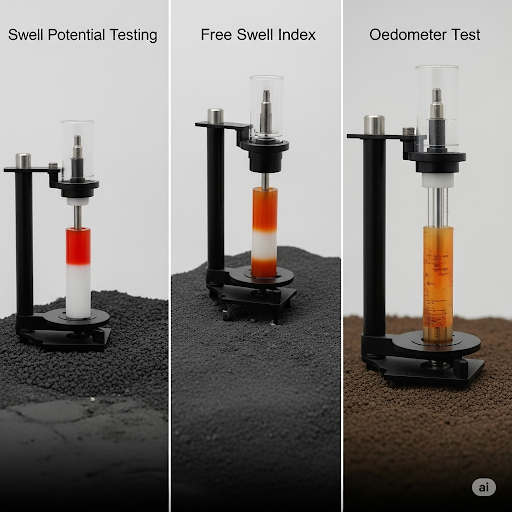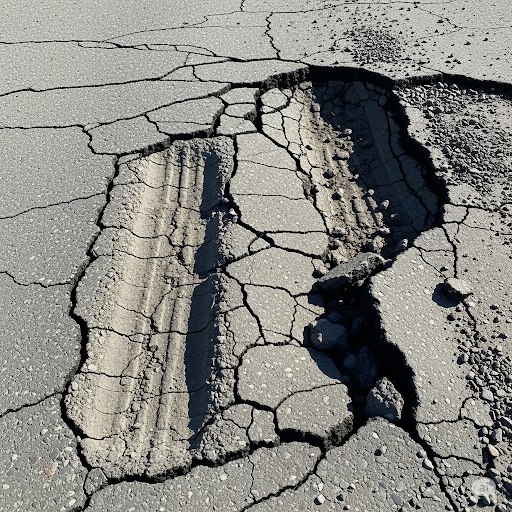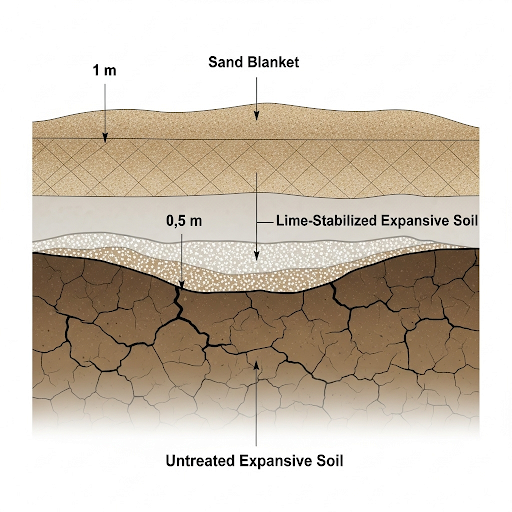2.8 - Swelling and Shrinkage Behavior
Enroll to start learning
You’ve not yet enrolled in this course. Please enroll for free to listen to audio lessons, classroom podcasts and take practice test.
Interactive Audio Lesson
Listen to a student-teacher conversation explaining the topic in a relatable way.
expansive soils
🔒 Unlock Audio Lesson
Sign up and enroll to listen to this audio lesson

Today, we’re discussing expansive soils. These are soils that swell when wet and shrink upon drying. Can anyone share an example of expansive soil?

I think black cotton soil is one of those.

Correct, Student_1! Expansive soils like black cotton soil can cause serious issues in engineering. They can lead to cracking or heaving of structures. Why do you think that is?

Because of the volume change, right? They change size when they absorb or lose water.

Exactly! This behavior is crucial to consider in pavement design. Let’s remember the term 'Swell' – think of it as 'swelling' under pressure from water.
swell potential testing
🔒 Unlock Audio Lesson
Sign up and enroll to listen to this audio lesson

Now let’s explore how we determine the swell potential of these soils. What tests have you heard of?

There's the Free Swell Index and the Oedometer Test.

Right! The Free Swell Index measures how much a soil can swell without any pressure applied. Why is understanding this important?

So we can predict how it will affect structures on top of it?

Exactly! Furthermore, the Oedometer Test tells us the swelling pressure, which is equally important for predicting pavement performance. Let’s use 'F-S-O' for Free Swell-Oedometer!
effects on pavements
🔒 Unlock Audio Lesson
Sign up and enroll to listen to this audio lesson

Let’s connect our previous topics to pavement performance. How do you think swelling affects pavements?

It can cause cracking and rutting.

Great observation! The deformities in pavements may lead to accidents and increase maintenance costs. Can you imagine a pavement that cracks up because the soil underneath is moving?

Yeah, and I guess it would need special treatment like lime stabilization?

Exactly! Mitigation measures such as lime stabilization and using sand blankets aid in managing the moisture content. Remember 'Lime for Stability' as a mnemonic!
Introduction & Overview
Read summaries of the section's main ideas at different levels of detail.
Quick Overview
Standard
Expansive soils exhibit unique swelling and shrinkage behaviors due to moisture changes, leading to various detrimental effects on infrastructure. Understanding swell potential and appropriate mitigation measures is essential for effective pavement design.
Detailed
Swelling and Shrinkage Behavior
Overview
Swelling and shrinkage behavior is a critical factor in geotechnical engineering and pavement design, particularly in areas where expansive soils are prevalent. These soils undergo significant volume changes due to moisture variations – they swell when saturated and shrink upon drying. This behavior can lead to serious structural issues such as cracking, rutting, and heaving in flexible pavements.
Expansive Soils
Expansive soils, such as black cotton soil, are known for their high plasticity and swelling potential when wet. Understanding the swelling characteristics of these soils is essential to predict how they will impact structures built upon them.
Swell Potential Testing
To evaluate the swell potential of soils, various tests are conducted:
- Free Swell Index: This test measures the amount of swelling without any applied pressure, providing valuable insight into the material's swelling characteristics.
- Oedometer Test: This method helps determine the swelling pressure of soil samples under controlled conditions, essential for understanding how they will behave in real-world applications.
Effects on Pavements
The effects of swelling on pavement structures can be substantial. Expansive soils often cause:
- Cracking: Regular pressure changes lead to surface cracks in pavements.
- Rutting: The deformation of the pavement surface unevenly under load.
- Heaving: When soil moisture content changes, causing the ground to lift unexpectedly.
Mitigation Measures
Mitigating the effects of swell in expansive soils often involves specific treatments:
- Lime Stabilization: Adding lime can reduce plasticity and swell potential.
- Sand Blankets: These can help manage moisture content and provide stabilization.

For transportation engineers, understanding the swelling and shrinkage behavior of soils is vital to ensure the durability and stability of roadways.
Youtube Videos










Audio Book
Dive deep into the subject with an immersive audiobook experience.
Expansive Soils
Chapter 1 of 3
🔒 Unlock Audio Chapter
Sign up and enroll to access the full audio experience
Chapter Content
Expansive soils are soils that swell when wet and shrink when dry (e.g., black cotton soil).
Detailed Explanation
Expansive soils have a special property of changing volume based on moisture content. When these soils absorb water, they expand, which can lead to issues like cracks in roads or foundations if not managed properly. Conversely, when they lose moisture, such as during dry seasons, they shrink. This behavior can adversely affect structures built on them because the cycles of swelling and shrinkage can lead to instability.
Examples & Analogies
Think of a sponge. When you soak it in water, it puffs up and takes in more water; similarly, expansive soils swell when they get wet. When you take the sponge out and let it dry, it shrinks back down. This is like what happens with expansive soils during dry spells, and such behaviors can create problems for buildings, roads, and other infrastructure.
Swell Potential Testing
Chapter 2 of 3
🔒 Unlock Audio Chapter
Sign up and enroll to access the full audio experience
Chapter Content
Testing for swell potential involves the Free Swell Index and swelling pressure determination using oedometer.
Detailed Explanation
To understand how much a soil might swell, engineers conduct swell potential tests. One common test is the Free Swell Index, which measures the amount a soil expands when water is added. Additionally, oedometer tests help determine the swelling pressure, which is the pressure exerted by the soil when it swells. These tests give valuable information to engineers, allowing them to predict how the soil will behave under different moisture conditions and take necessary precautions.
Examples & Analogies
Imagine filling a balloon with water. The amount the balloon expands as you add water mimics the swelling of soils. Testing the swell potential is like measuring how much the balloon can expand before it bursts. Engineers use these tests to make sure buildings and roads are designed to withstand the pressure created by opposing forces like swelling soils, much like ensuring that the balloon doesn’t pop.
Effects on Pavements
Chapter 3 of 3
🔒 Unlock Audio Chapter
Sign up and enroll to access the full audio experience
Chapter Content
The effects of swelling and shrinkage on pavements include cracking, rutting, and heaving in flexible pavements, requiring special treatments such as lime stabilization and sand blankets.
Detailed Explanation
Swelling and shrinkage of soils can create significant problems for pavements. As the ground swells, it can push up on the pavement surface, causing heaving. When it dries and shrinks, it can create voids beneath the pavement, leading to cracking and rutting. To address these issues, engineers often use techniques such as lime stabilization (adding lime to improve soil stability) or placing sand blankets (layers that help manage moisture) to create a more stable base for pavements. These strategies aim to reduce the damage caused by the movements of expansive soils.
Examples & Analogies
Imagine the pavement as a sheet of ice covering a lake. When the water below the ice expands as it freezes, it can cause cracks in the ice. Similarly, the swelling soils push the pavement up, creating cracks and uneven surfaces. Just like engineers would reinforce an ice structure to prevent cracking, civil engineers use methods like lime stabilization to reinforce the soil under the pavement, ensuring it stays strong and stable during seasonal changes.
Key Concepts
-
Swell Behavior: Refers to the change in volume of expansive soils upon wetting and drying.
-
Swelling Pressure: The pressure exerted by swelled soil, crucial for pavement design.
-
Swell Potential Testing: Techniques like Free Swell Index and Oedometer Test to evaluate soil behavior.
-
Impact on Pavements: The consequences of swelling including cracking, rutting, and heaving.
-
Mitigation Techniques: Methods such as lime stabilization and sand blankets to manage swelling.
Examples & Applications
Black cotton soil is known for its high swelling capacity, impacting infrastructure.
When exposed to rain, expansive soils can swell significantly, potentially causing pavement damage.
Memory Aids
Interactive tools to help you remember key concepts
Rhymes
When wet soils expand and grow, when they're dry, down they go.
Stories
Imagine a sponge soaking in water, it grows larger. But when you squeeze it dry, it shrinks back. Similarly, expansive soils change with moisture.
Memory Tools
Soils can 'S'well and 'S'h...rink: S = swell, S = shrink.
Acronyms
USE SWELL to remember
U=Understand
S=Study
E=Evaluate
S=Stabilize
W=Water content
E=Effects on pavements.
Flash Cards
Glossary
- Expansive Soils
Soils that increase in volume when hydrated and decrease in volume upon drying.
- Swell Potential
The capability of soil to expand due to moisture content changes.
- Free Swell Index
A test measuring the swelling potential of soils without applied pressure.
- Oedometer Test
A laboratory test to measure the swelling pressure of soils.
- Lime Stabilization
A soil stabilization technique using lime to reduce plasticity and swell potential.
- Sand Blankets
Layer of sand used to stabilize moisture content in expansive soils.
Reference links
Supplementary resources to enhance your learning experience.
